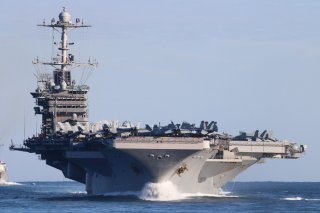China Threat To Sink An American Carrier: All Talk Or a Serious Possibility?
Will it make good on its threat? Could it?
That it is no easy task for anyone is clear. If China can’t find carrier task forces or vector PLA assets against them, it cannot deliver punishment on the scale of the America SINKEX. QED.
Which brings us to American tactics and operational practices. One trusts U.S. commanders understand they now cruise underneath the PLA’s shadow in the Western Pacific and are doing everything they can to foil schemes like Luo’s. If perchance they didn’t understand how grave the situation has gotten, they do now—thanks again, admiral!
A carrier is a big ship. It is tiny by comparison with the ocean, and can exploit being the veritable needle in a haystack. For instance, if a carrier group stringently regulates its electromagnetic emissions the way we cold warriors did—deploying a technique known as EMCON, for “emissions control”—it can limit if not entirely avoid giving away telltale clues to its location.
Task forces can also operate in congested waters, mingling with other traffic to clutter an enemy’s tactical picture. They can operate near shore, using coastal terrain to mask their whereabouts. They can make foul weather their friend. And so on. Creative options exist for forestalling an America scenario and have for many years. U.S. naval commanders should harness familiar standards from World War II and the Cold War while devising new methods of operational concealment, guile and deception.
So would Luo’s scheme work? Let’s ask the Magic Eight Ball: don’t count on it.
Now, there is a more feasible if somewhat less bloodthirsty variant of Luo’s bolt-from-the-blue stratagem: the PLAN could attempt a “mission kill” on two flat tops rather than trying to sink them. A mission kill knocks a warship out of action for a substantial time rather than destroying it. It subtracts combat power from an enemy force for a while—perhaps a long while depending on how long repairs take. Peppering a carrier’s flight deck with missiles or bombs could prevent it from launching or recovering aircraft, to take one obvious example, even if the ship remained otherwise intact.
A carrier with no working runway or flyable air complement is like a battleship with no working guns. Sending a “wake-homing” torpedo into its propellers would similarly incapacitate it. Deprived of propulsion, the flattop would be partly or wholly unable to maneuver to launch and recover planes for a time—carriers turn into the wind to help their planes develop lift under their wings—and perhaps unable to transit from point A to point B with its usual nuclear-propelled celerity.
Etc.
All of the above techniques for eluding PLAN attack apply to evading mission kills as well. The difference is that Operation Luo Lite would set a lower threshold for success while also, potentially, muffling the political shock value Luo craves. PLA attackers wouldn’t need to administer America-level punishment times two to make a less ambitious stratagem work.
But if China’s military envisioned executing a surprise attack as the opening salvo of a Pacific war, putting two carriers out of action—roughly 25 percent of America’s deployable carrier-borne striking power at any time—would constitute a serious contribution to operational and strategic success. This is a more thinkable move on China’s part—and one worthy of study in the halls of the Pentagon and elsewhere in the American defense community.
Let’s not assume Beijing would never gamble or is incapable of hurling such a thunderbolt. It might do both—as past foes did.
James Holmes is J. C. Wylie Chair of Maritime Strategy at the Naval War College and author of “Visualize Chinese Sea Power,” in the current issue of the Naval Institute Proceedings. The views voiced here are his alone. This article first appeared in January 2019. It is being republished due to reader interest. Image: Flickr

